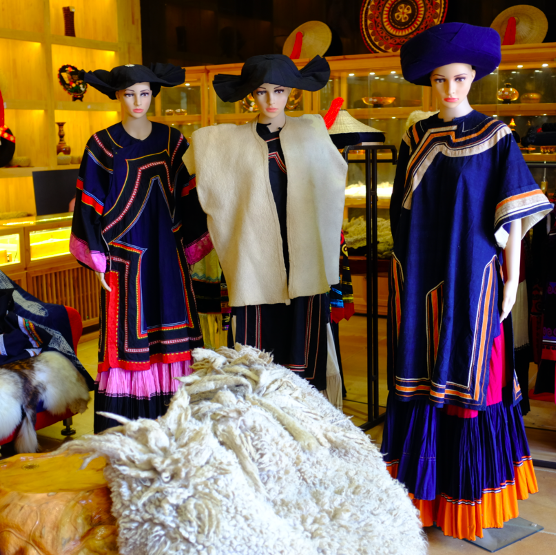This is a supplement to “Retro Nuosu: Reclaiming the Past, Present, and Future through Participatory Portraits in Southwest China” by KAITLIN BANFILL. Read the article here.
Banfill’s article explores visual and ethnic representation among Nuosu Yi youth in contemporary China, where photographic subjects’ desires and agency compete with mainstream visual regimes. In it, she argues that Nuosu Yi university students used self-fashioning and photography to create a new yet radically retro narrative—one that asserts their political and cultural modernity in the Chinese national imagination. “Art photo” studios have recently inspired youth to express themselves through a markedly retro Nuosu aesthetic. Banfill replicated an art photo studio and photographed fourteen individuals, revealing their individual desires and agency in the broader context of Chinese ethnic representation. In the activities below, you can try your own hand at examining the visual archive, taking a participatory portrait, and visiting a retro store.
Activity #1: Examine the Visual Archive
Watch several “ethnic minority social history videos” produced by the Chinese institute of social sciences in the 1950s during the early socialist era here: https://www.bilibili.com/video/av5689777/?p=2.
Video P2 is about Nuosu Yi, but the page also includes videos on twenty other Chinese ethnic groups, which will play automatically after the first video. You can watch several of the videos and compare them.
What kinds of images are used in these videos?
What might Banfill want to point out about these images based on her discussion of ethnic minority representations and image regimes in modern China?
This field was a popular place where students wanted to have their photo taken.
Activity #2: Take a Participatory Portrait
Ask a friend if you can take their photo
Ask them to wear clothing, accessories, or objects that they would like to be photographed with.
Brainstorm with your friend about possible locations to take the photo.
Schedule and carry out the “photo shoot.” Pay attention to the reflexive process between you and your friend.
Compile a “biography in dress.” Ask your friend to explain the history and significance of the clothing or items that they are wearing. Where did they find these items and why did they choose to wear them?
After the photo shoot, go through the photos with your friend. Which photos do you like best? Which do they like? If you like different photos, why do you think this is the case? What does this tell you about reflexivity in the photographic process?
Share your photographs and “biographies in dress” with your classmates.
A collection of vintage and retro garments for sale at a boutique in Xichang City
Activity #3: Visit a Retro Store
Visit a retro vintage/antique/ or second hand store in your area.
Observe and record what kinds of things are being sold in the store, including how they are organized and displayed.
What kinds of items are being sold? Why do you think these items are being sold?
Take a photo or document one object or piece of clothing. Why do you think this item was given away? Why do you think someone would buy it?
Compare you findings with your classmates. Create a collage of “found objects” with your classmates. Why do you think these objects have been collected and preserved? What does this tell us about the relationship between people and objects?
UPDATED DECEMBER 17, 2020



